Main Outcomes
The project outcomes are depicted below per main technology stream
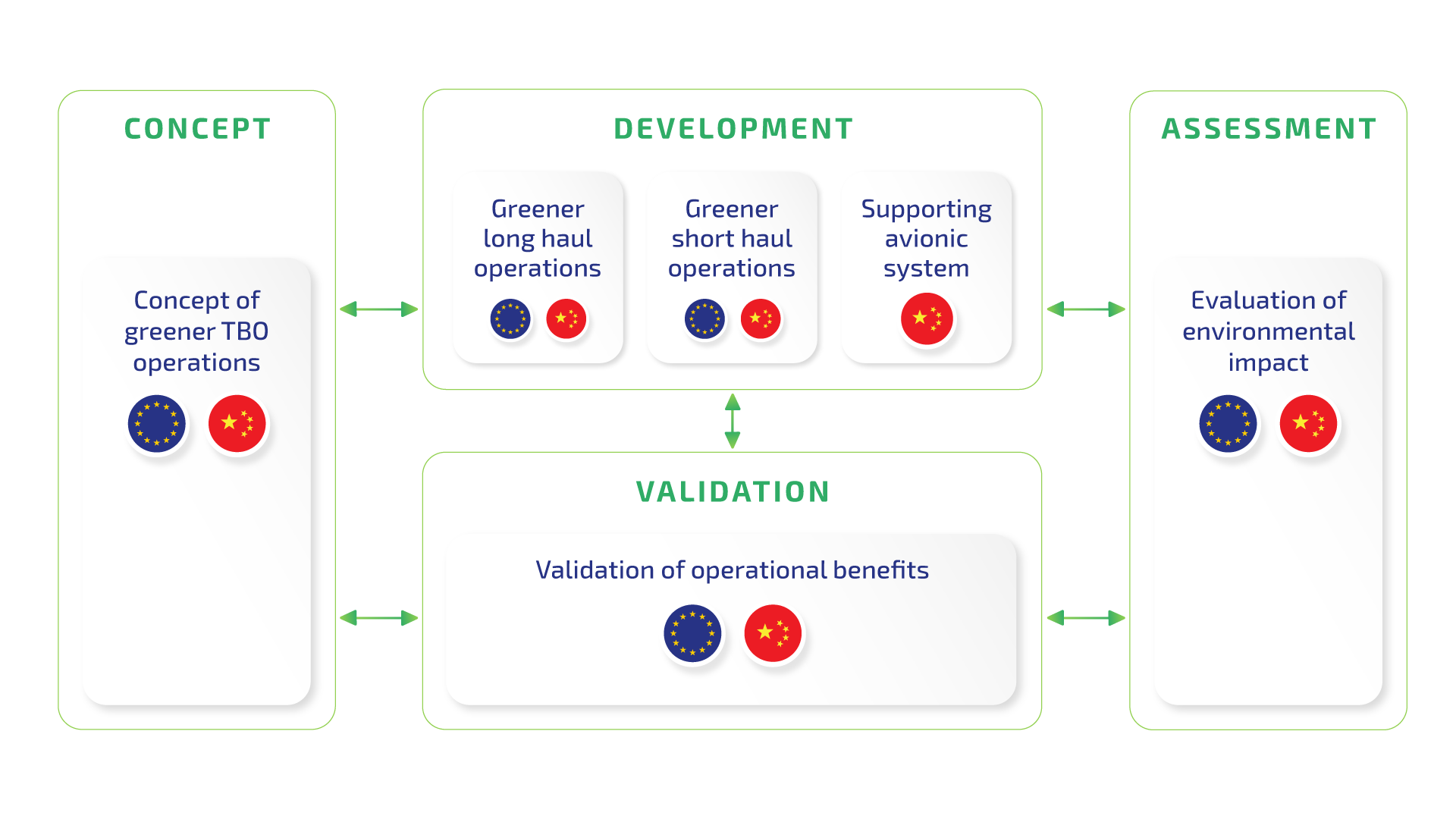

Concept of Greener Trajectory-Based Operations (G-TBO)
Objectives
- To develop new concepts for greener air traffic management by analysing the baseline situation and identifying future concepts between EU and China
- To develop and analyse a greener air traffic management architecture
- To validate the new concepts of greener air traffic management
Progress
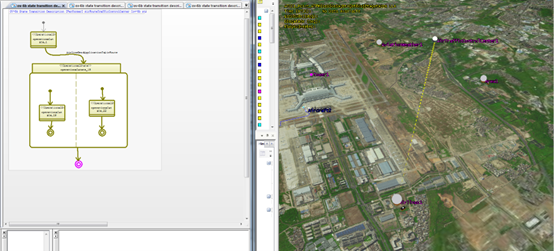
Fig. 1: Coordinated simulation process of architecture models and scenario for a greener operational concept scenario
With the validation of “Greener ATM Architecture Models” by the Chinese consortium, all activities related to the topic of “Greener Air Traffic Operational Concept” were successfully completed by July 2022. As a starting point for this task, validation metrics were defined thanks to the dedicated support of GreAT partner CIRA. The previously established architecture models and operational scenarios, which were also activities performed on the Chinese side, were linked and simulated in a synchronised environment. The results of the model execution and scenario simulation were presented and analysed in a validation report.
Architecture Validation
This last activity related to the development of GreAT’s “Greener Air Traffic Operational Concept” aimed to validate the previously developed ATM architecture and models. Three validation objectives were identified: Data consistency of the models, traceability between operational activities and system functions, and the conformance of the architecture with greener concepts. Based on the “Concept of Greener ATM Operations”, scenario analysis and MBSE (Model-Based Systems Engineering) were used to describe Greener Long-Haul Operations from the perspectives of scenario and architecture separately, forming a set of validation elements. These validation elements include executable models, visual scenario models, an activity-to-function traceability matrix and a dynamic sequence diagram. Based on these elements, several validation activities were performed for each of the three objectives. To support the validation activities, a joint simulation environment was developed, consisting of a SysML-based modelling tool, a visualized scenario simulation tool and a data exchange module. The validation results show that all objectives are achieved.
Outlook
Although the architecture validation process within GreAT is completed, further research is required to validate the operational performance of Greener ATM Concepts using the proposed method, particularly in terms of safety, efficiency and environmental impact. For example, attributes with quantitative data such as flight time, speed, distance, fuel consumption and ATCO (air traffic controller) workload need to be integrated into both the architecture and scenario models so that more meaningful results for analysis can be obtained through simulation.
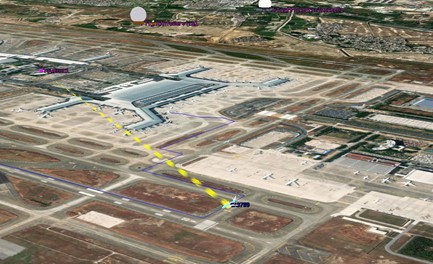
Screenshot of a "Greener ATM operational scenario" simulation
The completion of the overall concept for Greener Air Traffic Management in December 2020 laid the foundation for the detailed work on greener long-haul and short-haul flights. The development of the overall concept continued with strong support from the Chinese partners of the GreAT consortium to model ATM processes and systems, followed by validation of these models.
Modelling and Simulating Greener ATM Operational Scenarios
One activity performed in the frame of concept development is the modelling and simulation of overall greener ATM operational scenarios. With the submission of a corresponding report on the modelling of Greener ATM operational and system architecture in June 2021, all modelling work was successfully completed. At the same time, the validation of the created models commenced. The first step was to model the selected operational scenarios to prepare fast-time simulations. For this purpose, scenario data (terrain, trajectories) were collected and imported into a visual simulation tool. Subsequently, the operational scenarios, including the messages exchanged among stakeholders, were replicated and simulated in the tool.
Outlook
The next step will be to finalize the validation of modelled processes and systems, i.e., identification of validation metrics, followed by synchronized simulation runs of both architecture models and operational scenarios. The results will serve to refine the architecture models and will be published in the validation report.
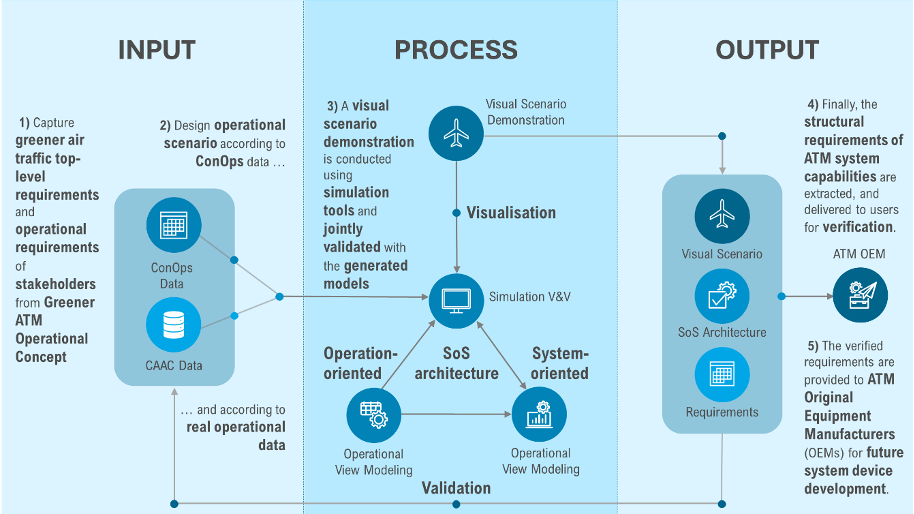
MBSE-based greener ATM architecture development process. Credit: CARERI
With the delivery of the “Concept of Greener Trajectory-Based Operations” (TBO), GreAT has reached its first important milestone. It provides the base for subsequent project activities, notably for developing procedures and avionics systems that enable reductions in fuel consumption and greenhouse gas emissions. In July 2020, the design of the architecture of an advanced operational and system architecture for greener air traffic management has started and is progressing on schedule.
Delivering a High-Level Operational Concept
With the submission of the “Concept of Greener Trajectory-Based Operations (TBO)” at the end of 2020, the GreAT consortium achieved the first project milestone. The TBO concept provides the high-level overall framework of GreAT and is the first step towards investigating and validating greener ATM concepts in the further course of the project. It gathers an initial set of greener concept ideas, illustrated by examples, and describes fundamental Greener Air Traffic Management (ATM) concepts. The findings serve as a basis for developing detailed procedures and the related necessary avionics systems to achieve substantial improvements in subsequent project stages. Once implemented, these concepts will lead to an advanced ATM in specific use cases (e. g. terminal maneuvering area (TMA) of a medium-size airport), capable of managing an equal or – preferably – even higher traffic volume than existing ATM systems, whilst enabling tangible reductions in fuel consumption and greenhouse gas emissions. Some of the conceptual ideas identified during this project stage will be presented at the DASC and EASN conferences later this year.
Creating a Reference Work
Furthermore, the developed TBO concept can also be considered as a comprehensive manual, as it summarizes the ATM features and ATM research basics in Europe and China, making it a global state-of-the-art reference work for scientists and other interested readers, who are probably familiar with only one out of these two ATM systems. The document was compiled thanks to the excellent Chinese-European collaboration and the strong commitment of all partners throughout a series of tutorials, workshops, brainstorming sessions, and progress meetings.
Defining an Advanced System Architecture
In parallel with the TBO conception, a subsequent work package related to the development of both operational and system architecture was launched in July 2020. It is led by the Chinese project partners and supported by the European partners. A model-based system engineering (MBSE) development methodology is used to design the greener ATM system architecture. From the operational perspective, it is necessary to identify the operational activities of each flight phase as well as the involved operational nodes, the information exchanges among these nodes, and the responsibilities and needs of all stakeholders. From the system perspective, the system components and the functional requirements of the systems and subsystems must be determined. The modeling tasks are on schedule.
Both architectures will be described in a new project deliverable, which shall be available in June 2021. It will describe the greener ATM architecture that links the high-level operational concept already worked out and subsequent technological research and systems development in other work packages of the project. It will also support the validation activities later in the project.
Outlook
The next step is the validation of the modeled architectures. It starts in June 2021 and will run over the period of one year. This stage will be supported by fast-time simulations of selected relevant ATM scenarios. The results will be compared to the high-level operational concept. The developed models will be iteratively improved according to the feedback from the validation process.
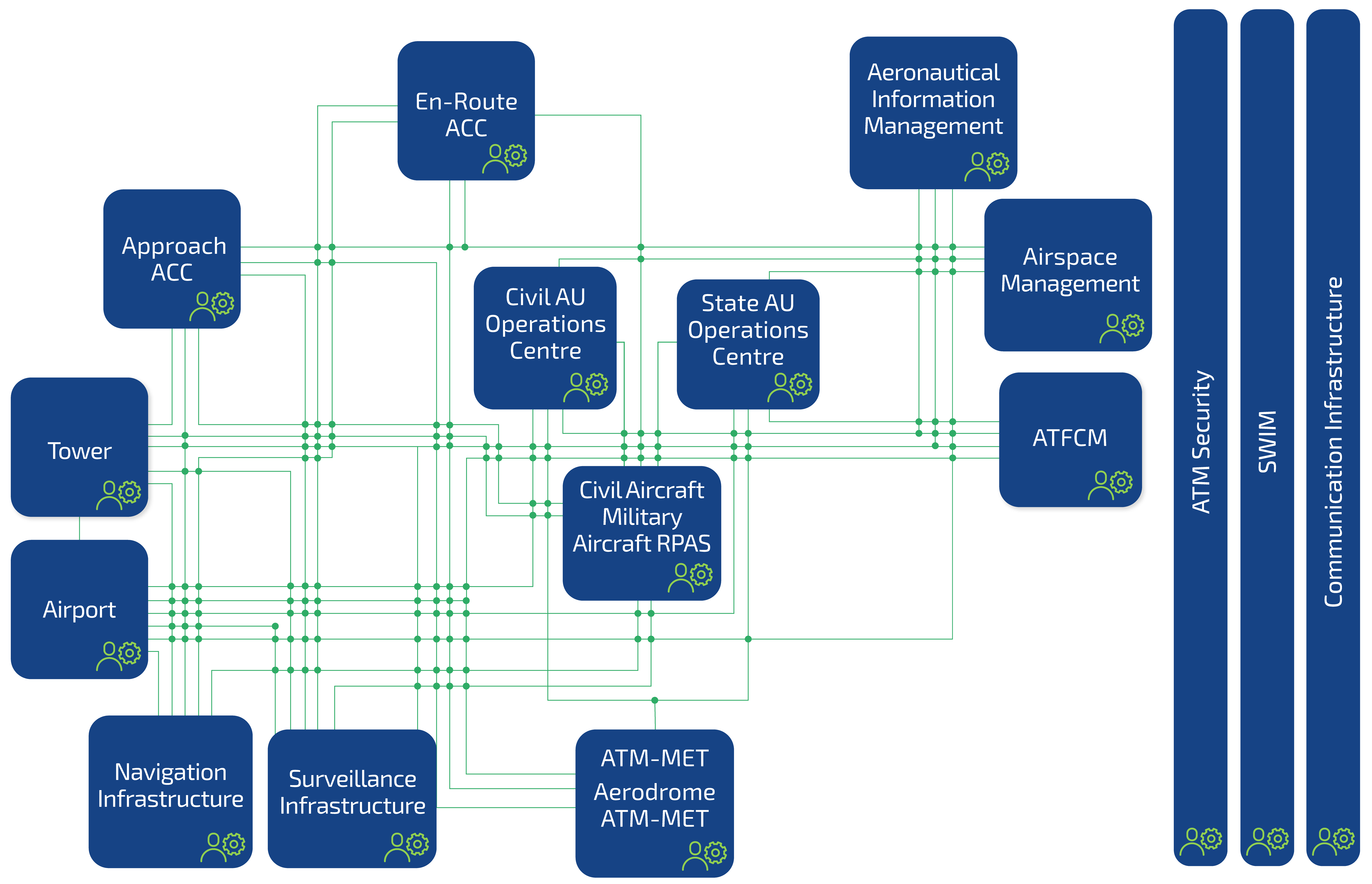
European ATM System Architecture Overview – source eATMportal
These activities have started jointly by Europe and China in March 2020. The key challenge is to develop a high-level environmentally friendly operational concept in line with International Civil Aviation Organization (ICAO) standards and the future ATM programs of involved countries. The activities related to greener air traffic management (ATM) concept research and development have made good progress despite the current COVID-19 circumstances. Four online tutorial sessions about the current ATM system and future programs in Europe and China were successfully conducted to gain a good understanding of how the current ATM system is working, and which improvements are expected and planned in the future. Related documentation was also exchanged between the different parties. Furthermore, ICAO requirements related to TBO were analyzed, and will be considered in the development of the future concept components. The remaining tasks, mainly dealing with the comparison between Europe and China as well as the development of the new concept elements, are expected to be achieved by the end of 2020. The part dedicated to Greener ATM architecture analysis and modeling has been started by the Chinese partners on July 2020. The validation of greener ATM architecture will be launched on 2021. The progress is monitored through monthly regular progress meetings. Moreover, the GreAT project places significant importance to the teamwork and exchange of experience and knowledge between Europe and China. At this end, a public team site was created to enable joint work on the deliverable and to share data together.

Greener Long-Haul Operations
Objectives
- To design flexible en-route airspace in the west of China (FERA-WoC) proposing regulations, methodologies and procedures for redesigning FERA-WoC;
- To develop technologies for environmentally friendly trajectory optimization based on integration and updating of air-ground information by developing mechanisms to fuse on-board and ground-based information to reduce cruising time, fuel consumption, and emissions in both fixed and flexible en-route airspace;
Progress
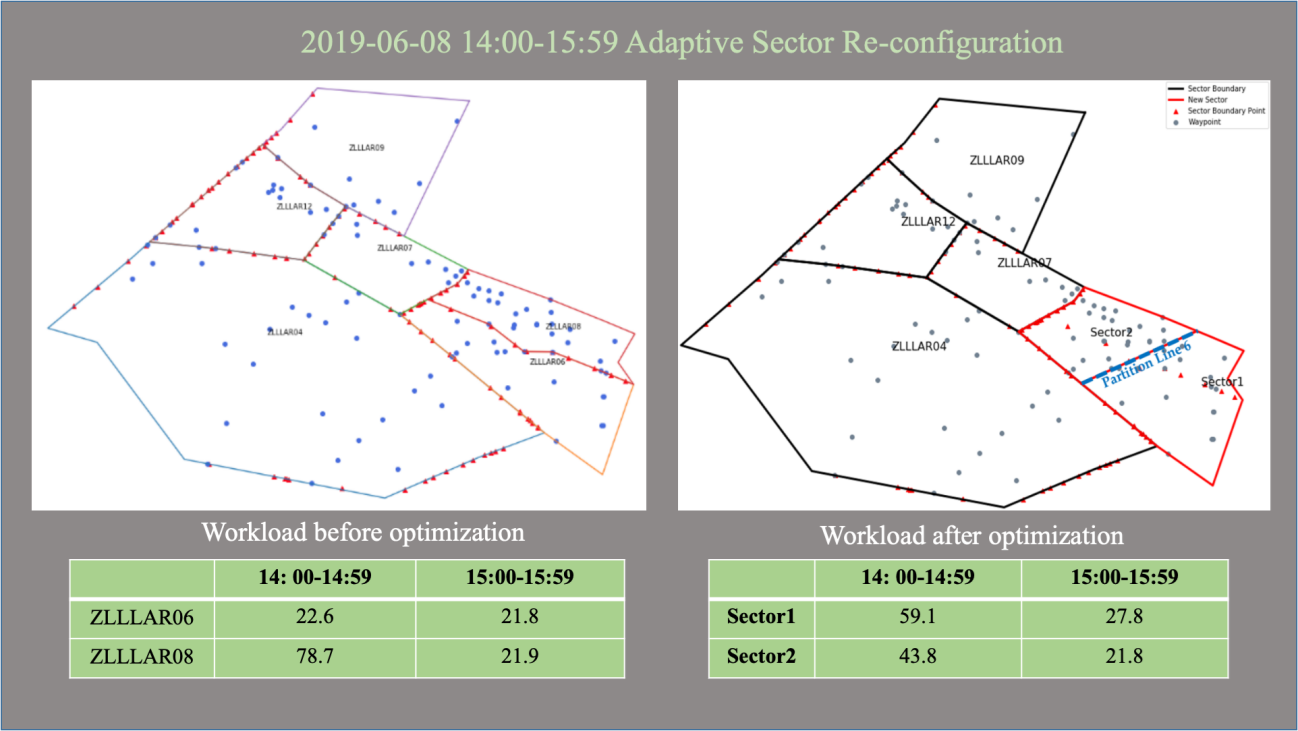
Fig. 2: Adaptive sector reconfiguration
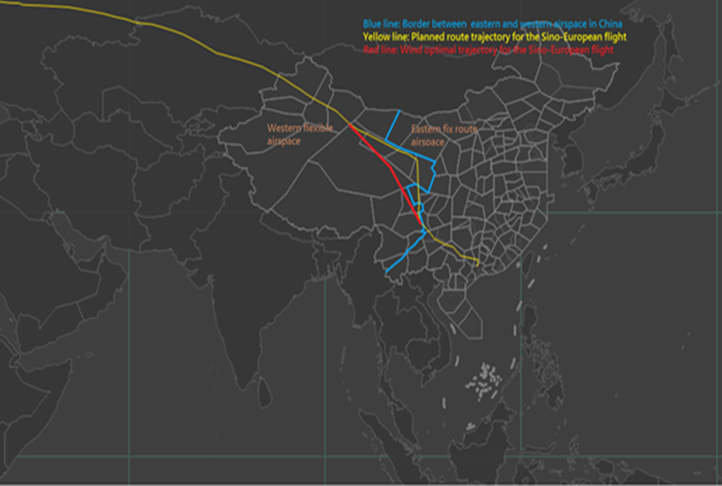
(a) : Optimised lateral route
(b) : Optimised vertical profile
Fig. 3: Optimised lateral (a) and vertical (b) profile for a long-haul flight passing structured and flexible en-route airspace
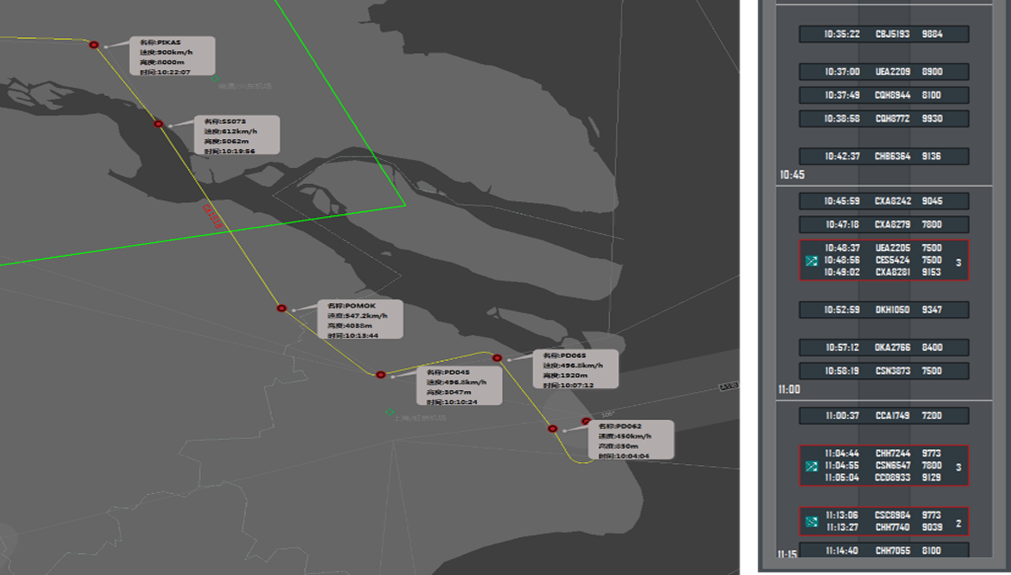
Fig. 4: 4DT calculation and conflict detection of the trajectory management and decision support tool
The dynamic configuration of the FERA-WoC sectors (Flexible En-Route Airspace in the West of China) has been developed. 4D trajectory optimisation models and algorithms that take into account the uncertain impact of the wind field as well as pre-tactical traffic deconfliction methods are hierarchically established. The tactical trajectory management and decision support tool for greener long-haul operations has been developed and is being assessed. All functions and tools are tested for a typical long-haul flight between Hong Kong International Airport (VHHH) and Amsterdam Schiphol (EHAM) and sectors along the way in China, including both structured and flexible en-route airspace.
Adaptive reconfiguration of FERA-WoC
Dynamic optimisation of sector boundaries adapting to the time-varying air traffic demand to balance the workload between sectors is fundamental but challenging for airspace management in the FERA-WoC to support user-preferred trajectories. By the end of October 2022, a machine learning-based and complexity-driven ATC workload estimation model for the FERA sectors was formulated and trained. A Binary Space Partition (BSP) model was used to efficiently search the optimal sector configuration schemes for the overloaded sectors and time periods. In particular, an automatic refinement algorithm was designed to tailor the new boundaries in order to ensure that as many as possible pre-planned entry and exit points or existing NavAids were set along the boundaries. The functions were verified according to the requirements previously defined in GreAT’s activities in the field of “Validation of Operational Benefits”.
Green Trajectory Optimisation based on FERA-WoC and integrated air-ground information
Optimisation models and algorithms for both the lateral and the vertical trajectory profile considering the impact of wind are hierarchically developed. The method for optimising the trajectory taking into account time-varying wind scenarios is currently being further developed. The uncertainty of the ECMWF (European Centre for Medium-Range Weather Forecasts) wind forecast, and the uncertainty of the trajectory route point arrival time prediction are both analysed. Pre-tactical traffic deconfliction methods are introduced. Considering the flying time uncertainty, robust trajectory deconfliction algorithm validation using historical data in structured and flexible en-route airspace is ongoing . By end of October 2022, performance validation for the optimised vertical trajectory profile and a robust trajectory deconfliction algorithm for several sectors were implemented.
ATM automation and air-ground collaboration for greener long-haul flights
Based on the trajectory optimisation and management method, a trajectory management and decision support tool for greener long-haul operations is developed, including functions of 4DT calculation (4D stands for the three spatial dimensions plus time as a fourth dimension), conflict detection, and conflict-free CTAs (controlled times of arrival) assignment. The typical adaptation data for FRA (free-route airspace) in western China is also integrated into the long-haul operation environment. In terms of verification activities, the main functions of the trajectory management and decision support tool are verified based on the simulated flight data.
Outlook
The operational procedures in FERA-WoC will be studied based on current ATC (air traffic control) practice in the corresponding sectors. Once the models and algorithms of trajectory optimisation are finalised, fuel consumption and flying time for the optimised trajectory will be validated against the planned trajectory. Performance of the robust trajectory deconfliction algorithm will also be validated with medium density traffic in sectors passed by the long-haul flight. In addition, we will continuously improve the trajectory management decision support tool according to the results of the verification activities. These will form the basis for the validations on the integrated simulation platform.
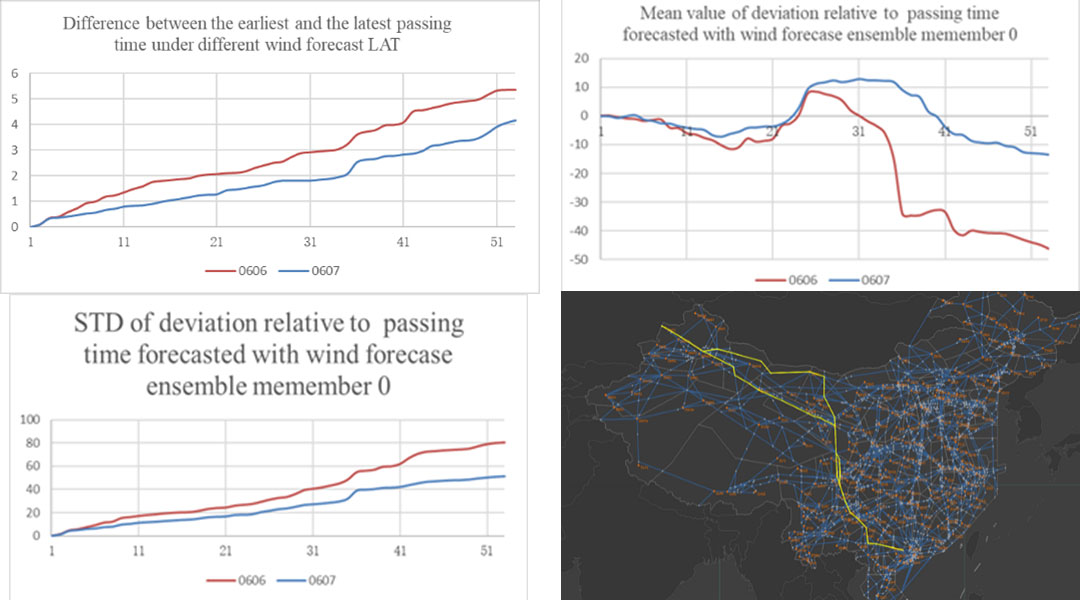
Ensemble trajectory probabilistic uncertainty analysis
Due to the pandemic, the project partners have still not been able to meet in person; the collaboration had to continue in web-based meetings. The intensive research work done so far within GreAT underpins progress in the field of "Greener Long-Haul Operations".
Complexity studies of Flexible En-Route Airspace (FERA) operations
The methodological and conceptual design of Heterogeneous En-Route Airspace Management (HERAM) last year focused on complexity studies. As a newly added goal, entry and exit points of the sectors to be allocated in FERA-WoC, a complexity measurement framework for FERA operation considering uncertainty, was established. Also, a complexity-based model for sector capacity estimation was evolved using pioneering machine learning technologies. A fast-time simulation using Transoft’s AirTOp (a gate-to-gate fast-time air traffic and airport complexity modeling, simulation and assessment software) supported by air traffic controllers (ATCOs) from Chinese NorthWest Air Traffic Management Bureau (ATMB) helping the validation of the baseline model will conclude this particular task.
Making more use of high-altitude wind for greener long-haul flights
A robust method for resolving trajectory conflicts considering wind uncertainties was studied and reviewed. To make the most out of the diverse project partnership, conflicts in the sectors in China crossed by flights between Guangzhou Baiyun International Airport (ZGGG) and Amsterdam Airport Schiphol (EHAM) were chosen as typical deconfliction traffic scenarios for the project.
The partners provided recommendations on the mechanism of collaborative trajectory management between air navigation service providers (ANSP) and airlines, and a conflict-free trajectory optimization model and algorithms for both structural and free-route airspace were developed.
The next important step is the design of an even more efficient and robust conflict resolution algorithm and its validation through fast-time simulation. Another major scientific milestone will be a wind-optimal trajectory algorithm for flights between China and EU within structured and non-structured airspaces.
ATM automation and air-ground collaboration based on FF-ICE
Research on 4DT-based collaborative traffic flow planning and management is completed. A conflict-free trajectory generation model has been developed to support the allocation of CTA/CTO (Controlled Time of Arrival/Controlled Time Over).
The architecture and process of air-ground and ground-ground trajectory negotiation have been proposed to support trajectory management and synchronization of both pre-departure and en-route phases. The preliminary development of verification objectives and scenarios for greener long-haul operations has been successfully completed. The corresponding tools for trajectory management and decision support are currently being developed. The next major step will be the validation of greener long-haul flights in typical scenarios.
Outlook
Activities related to “Greener Long-Haul Flights” are expected to be completed in the second half of 2022.
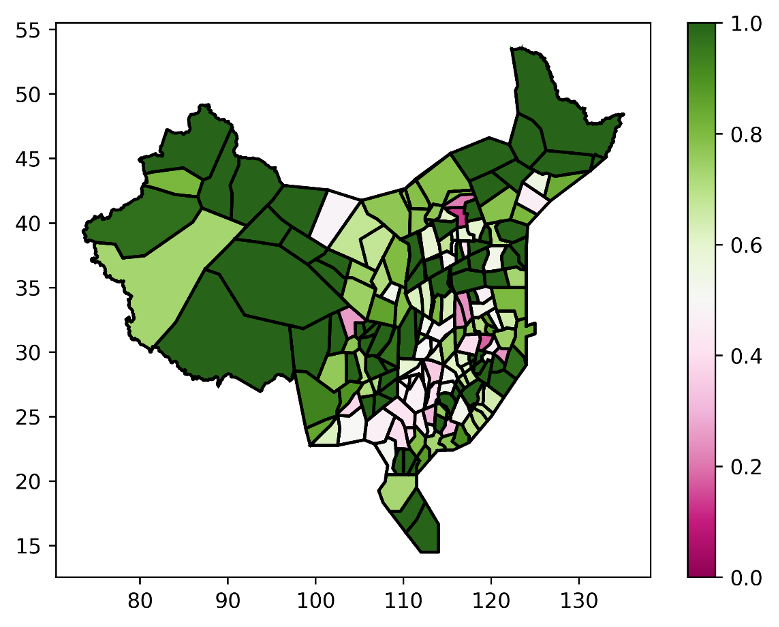
Resource Availability Map (RAM) of en-route air traffic in China. Credit: CARERI
To support the development of a concept for greener long-haul operations, three areas are being investigated: First, en-route airspace concepts of operations, second, advanced algorithms for conflict-free trajectories assignment optimized to greener long-haul flight planning under the TBO concept as well as within the proposed FERA-WoC approach, and third, the increase of the availability of user-preferred 4DT profiles and flexibility of air traffic operation.
Although face-to-face meetings were not possible due to the pandemic, the project partners have been collaborating in a highly efficient manner since the kick-off meeting. The central topic “Greener Long-Haul Operations” comprises three supporting work packages that are being worked on in parallel.
Flexible En-Route Airspace in the West of China
Concerning the first work package, flexible en-route air space design, the first milestone was reached in due time. The internal progress report provided the methodological and conceptual design of Heterogeneous En-Route Airspace Management (HERAM) based on the quantification of 3D airspace resource availability, and a modular framework of Flexible En-Route Airspace in West of China (FERA-WoC). This design and framework provide the basis for subsequent project activities: green trajectory optimization for long-haul flights as well as validation activities. The next step will be to develop detailed procedural and operational improvements that will enhance the flexibility and adaptability of en-route airspace in the west of China to support green trajectory operations without compromising safety and capacity.
The above-mentioned progress report also provides preliminary information for the subsequent work packages related to the overall topic “Greener Long-Haul Operations” to understand the profile of flexible en-route airspace.
Green Trajectory Optimization
In the second work package, the ensemble weather forecast data requirements were confirmed, and the air-ground wind data were prepared. Also, uncertainties concerning the analyzing method of the predicted high-altitude wind information were investigated. An important next step is to develop a trajectory prediction method under the influence of wind and the research of a robust trajectory deconfliction algorithm.
ATM Automation and Air-Ground Collaboration Based on FF-ICE
Finally, within the third work package, a study of the ICAO FF-ICE concept was delivered. Beyond that, the architecture of trajectory management for long-haul flights in the pre-departure phase has been established, and typical scenarios of greener long-haul flights based on FF-ICE have been designed. Next steps include the development of the air-ground coordination architecture, of a method for the in-flight phase as well the research of traffic flow, and finally a separation management method for greener long-haul flights.

Two approaches for improving long-haul operations are proposed. The first is to develop a Heterogeneous En-Route Airspace Management (HERAM) concept by identifying the boundary to divide China’s en-route network into the eastern (fixed route) and western (flexible route) region, putting focus on the planning of Flexible En-Route Airspace in the West of China (FERA-WoC). Designing and implementing a new-type airspace with high degree of freedom, known as “Free Route Airspace” (FRA), is an essential mean to support the Greener Trajectory-Based Operations (G-TBO).
The second approach is to optimize long-haul flight trajectories based on integrated air-ground information (e.g., traffic situation, dynamic upper wind field), which aims at achieving a wind-optimal path and flight profile to decrease total fuel consumption and emissions during long haul flight in both structured and flexible en-route airspace. The main purpose is to improve the flight trajectory efficiency of the flight across China and Europe, in order to reduce the cruising time, fuel consumption and emissions and to support the above-mentioned trajectory optimization. This is done by promoting the air-ground cooperative operation of long-haul flights through the concept and technologies of FF-ICE, as well as increasing the availability of user-preferred 4DT profiles and flexibility of air traffic operation.
These research activities are mainly carried out by the Chinese consortium and are supported by European partners contributing experiences from research work in Europe.
These activities started in July 2020. Partners agreed on a detailed workplan and schedule, that takes into account the outcomes of and experience gained in the Concept for Greener TBO operations

Greener Short-Haul Operations
Objectives
- To develop new concepts for airspace structures to enable environment-friendly continuous climb and descent operations;
- To develop enhanced ATC decision support tools based on Arrival Management Tools (AMAN), Departure Management Tools (DMAN) and Surface Management Tools (SMAN), enabling greener gate-to-gate trajectories incorporating optimized airborne and taxi 4D trajectories;
- To improve existing ATC decision support tools with enhancements based on data analysis for greener short-haul operations;
Progress
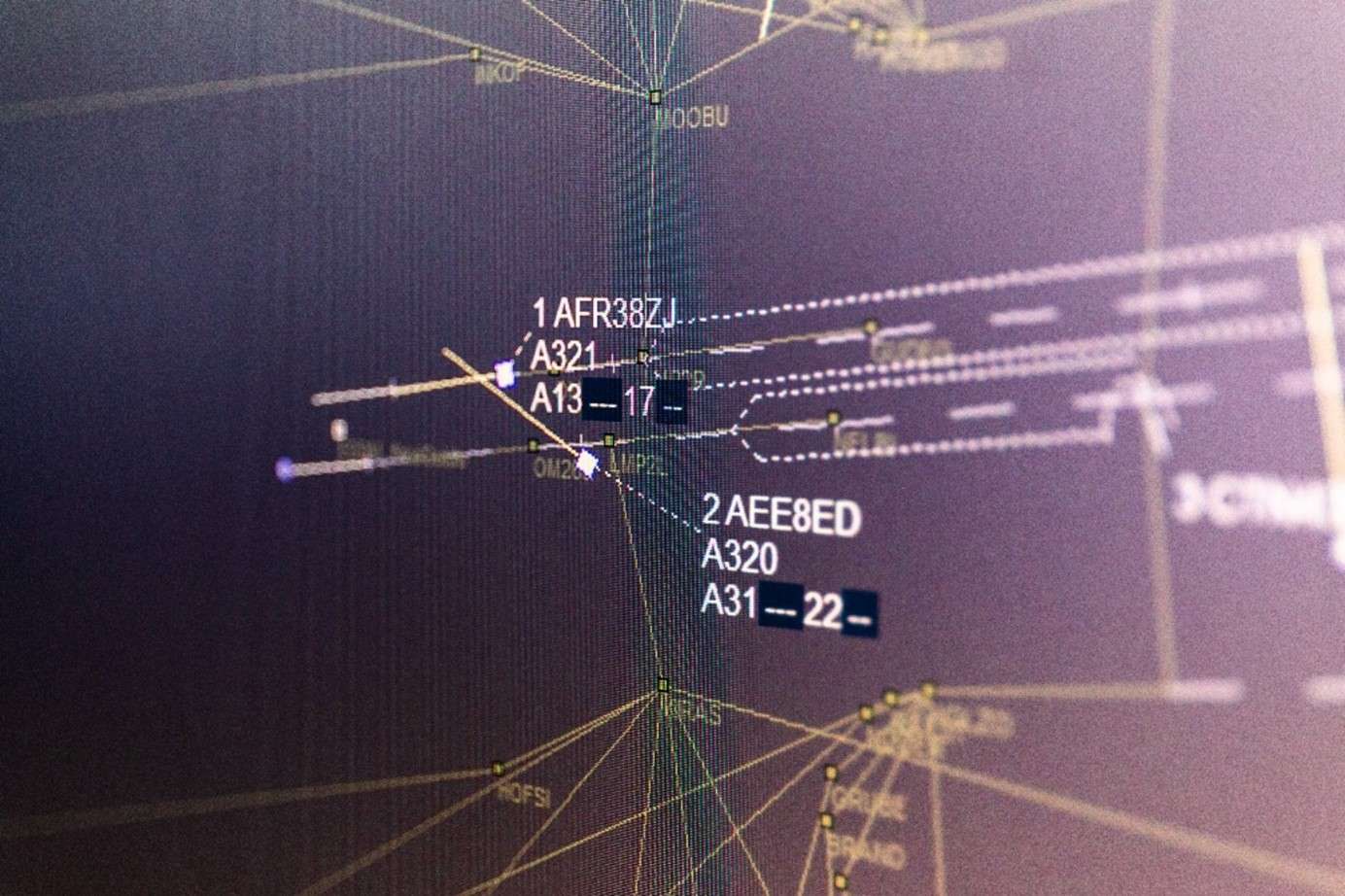
Fig. 5: Controller support tool TargetWindows on the primary display RadarVision at DLR’s Air Traffic validation Center in Braunschweig
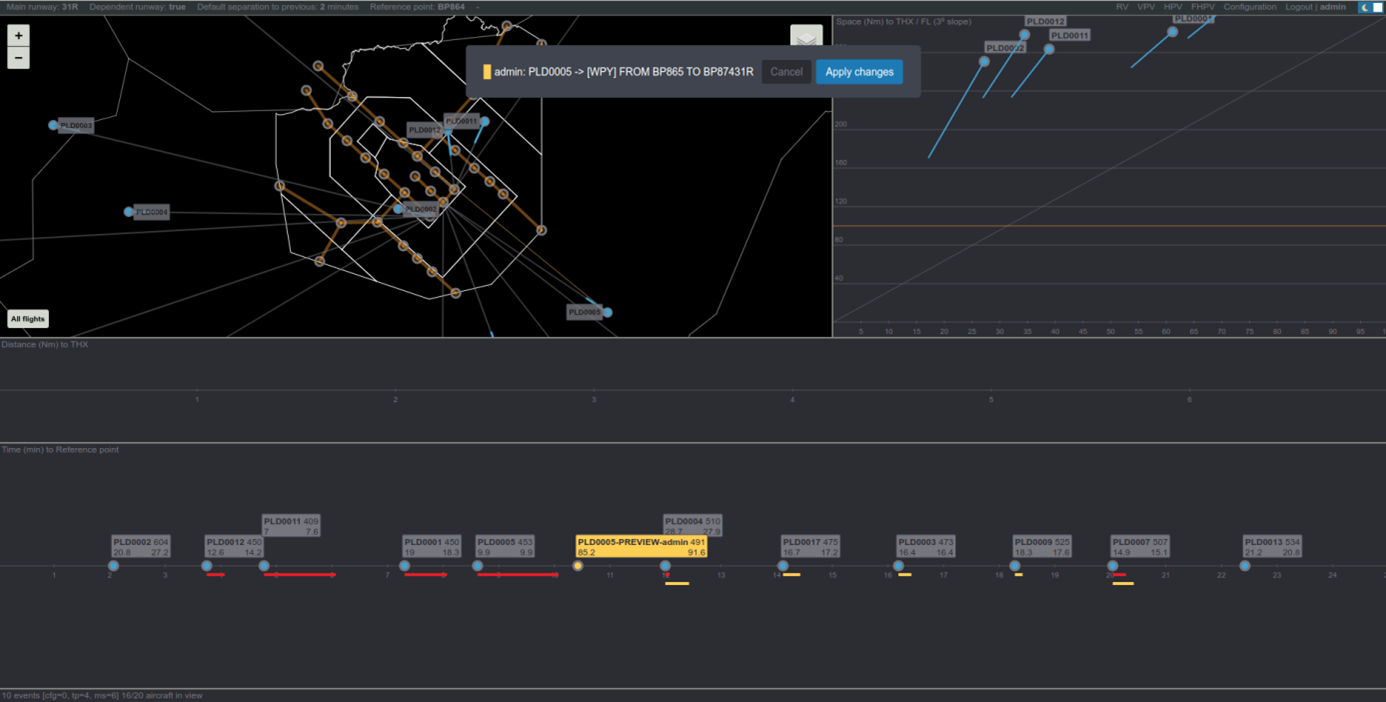
Fig. 6: MergeStrip web application at peak hour
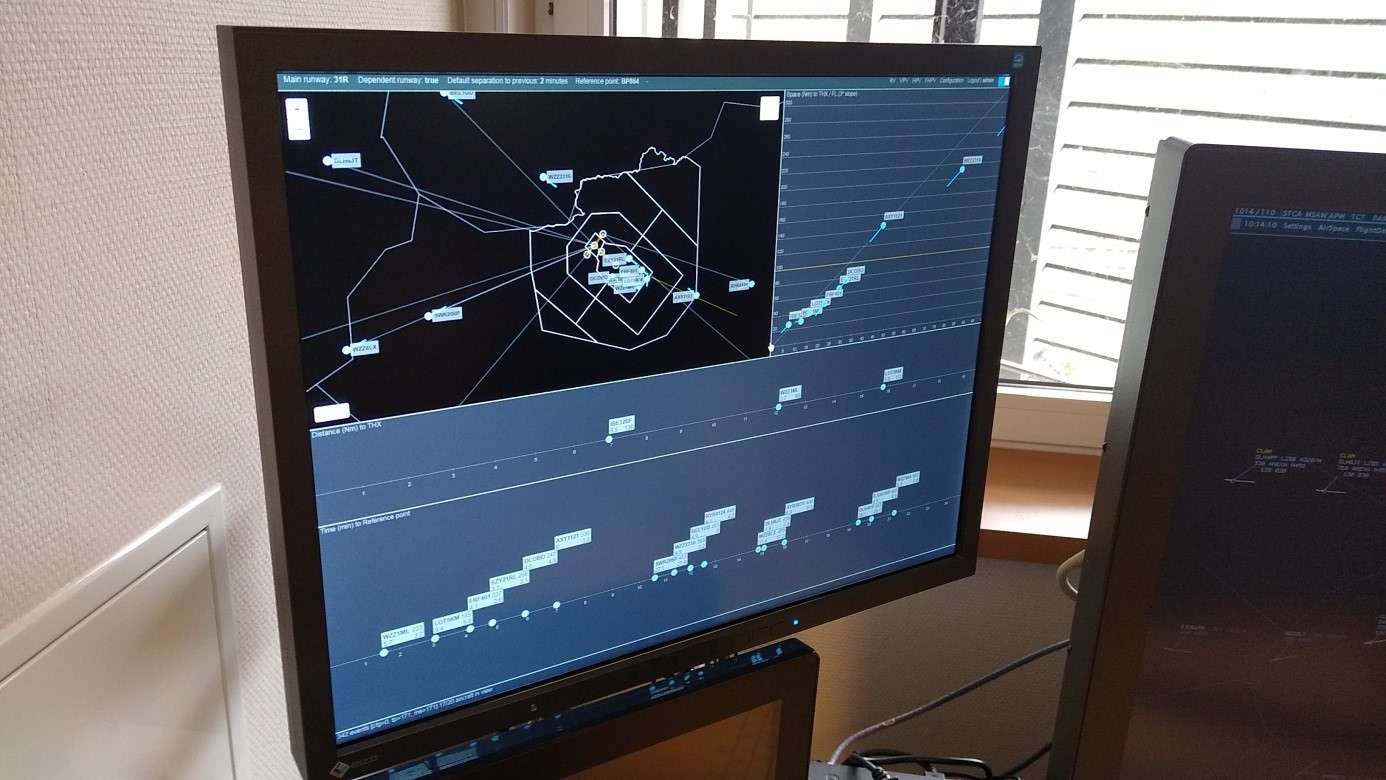
Fig. 7: MergeStrip installed in the simulator for validation purposes
The first and second campaigns of the DLR validation trial on the new airspace structures and the controller support systems for maintaining environmentally friendly approach routes and procedures were successfully completed. For MergeStrip, a support tool developed by HC and Pildo Labs, the validation environment was defined and implemented, and two validation trails were conducted. These human-in-the-loop sessions, each lasting two days in HC’s MATIAS-BEST simulator, were used to validate a ‘What-if’ function. As third validation trial, the 4DT-based sequencing and scheduling prototype developed by the Chinese consortium, and user interfaces were verified and transferred into the simulation environments for validation for different Chinese airports.
Development of controller support systems
After completion of the development and implementation work, DLR conducted some of the trials at their premises in Braunschweig to validate the performance of the new systems and airspace structure. The goal was to support air traffic controllers in organising the airspace and airport apron to reduce flight routes and taxiing maneuvers through more efficient and automated planning and information displays.
Many modern aircraft are already equipped with systems that enable them to perform an approach that is optimally adapted in terms of kerosene consumption and aircraft noise. However, integrating these individual approaches into general traffic presents air traffic controllers with air traffic control challenges that cannot be met with today's systems without a loss of traffic capacity. During the tests in the air traffic validation center at the Institute of Flight Guidance Braunschweig, approach controllers received visual and planning support for the integration of kerosene-saving flights in an adapted airspace structure. They tested various display systems with integrated guidance support functions and trajectory negotiation processes and successfully validated them for their performance in organising airspace.
Further high-speed simulations showed that the TRAMICS+ ground support system can organise the taxiing process on the airport apron with fewer intermediate stops than today by means of adapted roll coordination. This is very important for the environmental impact assessment, since especially the acceleration phase after a stop produces emissions during the taxi phases.
MergeStrip
In this last project implementation period, most of the efforts related to software development were focused on the ‘What-if’ function. The first version was tested in September in a simulator environment with human-in-the-loop at HungaroControl premises. The basic logic behind the implemented functionality received positive feedback from the ATCOs (air traffic controllers), who will be the actual users of this decision support tool. They found the application useful, easy to handle and to adapt. All requests were implemented for an additional, second iteration that took place in November. This extended, improved version induced a few more ideas from the ATCOs which is to be tested during the final validation round end of January 2023.
During these validation sessions, human factors questionnaires were completed as is standard practice in ATM validation. The findings will be incorporated into the first Validation Report. The safety analysis will take place during and after the final round of validations.
The development of AI-based functionalities continued until December 2022 and shall be validated in early 2023. The exact definition of the development environment for ML-based (machine learning) functionalities will be determined together with the developer. The corresponding validation exercises will take place after the final version of the application is integrated into HungaroControl’s ATM-R environment.
4DT-based sequencing and scheduling
Based on the work progress achieved by the Chinese consortium by the end of 2021, the research team continued to develop and improve the prototype system of the 4DT-based sequencing and scheduling functions from early 2022. In the meantime, the user interface development has been completed, and the prototype function modules have been constantly refined to resolve technical problems and challenges found in the verification.
The improvements include system stability, algorithm reliability and interface consistency. The entire prototype was then migrated to the simulation environment, where simulation data for several typical Chinese airports was prepared for further testing.
Meanwhile, initial efforts have been made to integrate the prototype into a distributed simulation and validation platform for overall validation of the greener operation technology proposed in GreAT. To this end, the Chinese partners involved have recently specified the interface and data standardisation.
Outlook
Now that most of the validation runs have been completed, all measurement results from the trials are being combined and evaluated in terms of their environmental impact. The 4DT-based sequencing and scheduling will now be implemented in the simulation environments of some Chinese airports and tested for reliability and efficiency.
The final validation of the ‘What-if’ function of Merge Strip will be carried out in January 2023, whereas the simulation environment for ML-based functionalities is under establishment and scheduled to start in February 2023.
-of-the-prototype-system-for-4DT-based-sequencing-and-scheduling.png)
User interface (UI) of the prototype system for 4DT-based sequencing and scheduling
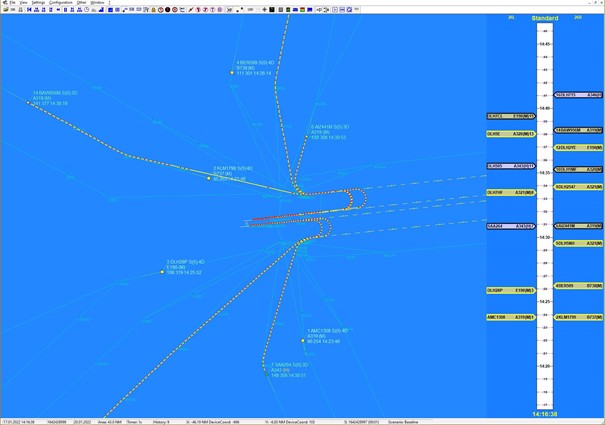
Prototypic radar display RadarVision with AMAN-scheduled approach trajectories and negotiated target times for 4D-FMS equipped aircraft
The scheduling models and algorithms based on 4D trajectories (4DT) for arrival and departure flights are now established for metroplex areas in China. Using historical data, 4DT calculation modules and the conflict resolution are integrated and tested. MergeStrip development started with a series of user requirement workshops to explore ATCO expectations. For the validation phase, 4DT negotiation processes are implemented into DLR’s arrival planning system 4D-CARMA and the traffic simulator NARSIM. The TraMICS+ ground system is currently expanded to provide functions to calculate green surface trajectories without conflicts, no holds and a low number of speed changes.
4DT-based Sequencing and Scheduling
Studies of terminal area environment and operation challenges concerning metroplex areas in China enabled to establish the scheduling models and algorithms based on 4DT for arrival and departure flights. Design and development of the prototype system (function analysis, module division and information interaction relationship) for 4DT-based sequencing and scheduling are ongoing. By the end of 2021, the data processing, conflict resolution and 4DT calculation modules were developed and integrated into the prototype after being tested using historical data. The design phase of the user interface (UI) of the prototype system is completed and the system is currently being developed (see figure "User interface (UI) of the prototype system for 4DT-based sequencing and scheduling").
Controller Support Systems Development
After design and implementation of the GreAT airspace structure around an airport topology with a runway system consisting of two parallel and independent runways, the 4D trajectory negotiation processes were implemented into DLR’s arrival planning system 4D-CARMA and the traffic simulator NARSIM (see figure “Prototypic radar display RadarVision with AMAN-scheduled approach trajectories and negotiated target times for 4D-FMS equipped aircraft”). Besides providing the complete air traffic on and around the airport, NARSIM supports Advanced Flight Management Systems (A-FMS) of each aircraft in the validation simulations. For the validations, the 4D-CARMA has to contact all arriving aircraft and to negotiate individual target times with them for selected waypoints and the threshold on the assigned runway. After agreement between ground and board systems, 4D-CARMA integrates the aircraft with the fixed route and target times into the current and all future routing and sequencing calculations, until the diversion of the aircraft exceeds defined spatial or temporal limits or lands.
Currently, the TraMICS+ functionalities and algorithms are expanded to support the calculation of green surface trajectories. The TraMICS+ prototypical software tool will provide essential functions of SMAN and DMAN support systems to calculate green surface trajectories. The aim is to provide surface trajectories with no conflicts, no holds and a low number of speed changes. With a fuel consumption prediction currently under development to quantify the expected fuel use for each individual calculated ground trajectory, a new selection criterion for the route choice will be available for integration.
In terms of verification process, artificial traffic scenarios were arranged for the simulators, which includes possible conflicts and incidents to test the conflict detection algorithms.
MergeStrip
Software development started with a series of user requirement workshops in order to explore ATCO expectations, as they will be the end users of this decision-making support tool. Subsequent discussions involved experts from Pildo Labs (who carry out the actual developments) to check the feasibility from the developers’ perspective. HungaroControl attaches high importance to involving human safety expertise at a very early stage of concept development to gather recommendations (e.g., on HMI development) and experience from previous projects.
This pioneering and complex development involves not only ‘conventional’ but also AI-based software. Therefore, platforms with real data have to be used in both the development and validation phases. The definition of the development environment for AI-based extensions is almost complete, so that integration into the relevant platforms can take place soon.
Outlook
Once tool development and implementation are finalized, the next steps will be the generation of traffic scenarios to conduct verifications in the simulation facilities. These will form the basis for the validations of the individual systems, in which several systems will interact to jointly generate environmentally friendly optimization solutions for different traffic situations on the ground and in the air.
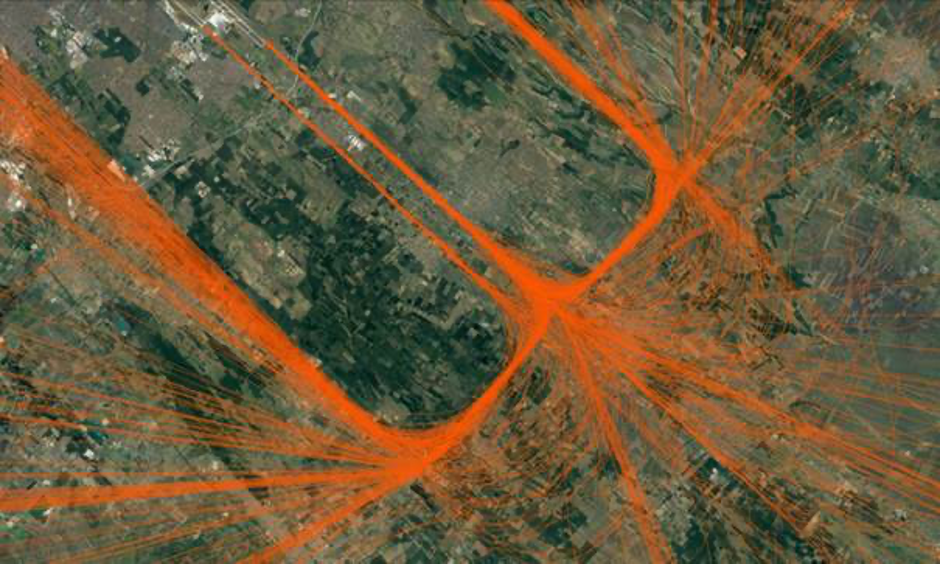
Flight tracks of aircraft using the T-bar airspace structure at Budapest airport. Credit: HungaroControl
A key step enabling the implementation of the Greener Short-Haul Operations Concept is to set up different use cases and to test the concept. The preparatory work of use case design, describing the system components as well as their interaction, was completed in April 2021, thus enabling the consortium to enter the Airspace Design Phase and to integrate new functions in the planning and support systems as scheduled. The Short-Haul Operations Concept focuses on two main aspects, namely approach procedures and decision support systems for controllers.
Airspace Design and Approach Procedures
The airspace in the vicinity of each airport is unique. The specific topography (e. g. mountains) as well as prevailing meteorological conditions have a decisive influence on design, layout and use of the runways.
In GreAT, several airspace design ideas have been investigated, from upgrading existing design and methods to conceiving completely new ideas. For instance, the project team gathered some key elements of the existing Point Merge Airspace Design Concept, because they are meaningful in terms of saving fuel during approach procedures and promising in terms of reducing aircraft noise in the wider surrounding of an airport. Besides adopting approved procedures, the team has also developed completely new ideas, for example treating approaching traffic depending on the respective on-board equipment of each aircraft. With the Early Full Clearance Approach procedure designed by DLR, aircraft with Advanced Flight Management Systems (A-FMS) on board can already receive approach clearance at the top of descent until the final approach segment. This enables pilots to perform an Optimized Profile Descent (OPD) that is best tailored to the aircraft and thus reduces fuel consumption nearly to the technical minimum.
Enhanced Controller Support
In parallel, the project team has worked out new support functions for controllers to facilitate approach, surface and departure flight phases both in the vicinity of individual airports and in metroplex airport constellations. The required coordination effort between the ATC sectors responsible for the different flight phases is still enormous and increases exponentially with the number of closely located aerodromes. Current planning systems focus predominantly on individual flight phases and the associated resources.
It has been shown time and again that individually optimized arrivals and departures using both the same runways, taxiways and airspaces may adversely affect the efficiency of other flights. To prevent this negative effect and to achieve the global system optimum, planning systems must be coordinated. Furthermore, the concepts include support functions for controllers to guide aircraft in the new airspace conducting Early Full Clearance Approaches and safely monitor the execution. Once the support systems are in place, the next challenges will be to develop the coordination procedures and to implement the interfaces.
Optimized Approach Sequences
Smaller and medium-sized airports will benefit from another detailed technical concept, which is the T-Bar Airspace in combination with the MergeStrip System. Since its introduction, this concept has enabled a significant increase in the prediction accuracy of landing times, and thus an optimized approach sequence. As with the Early Full Clearance Approach, MergeStrip allows pilots to program their FMS to perform an OPD. Initial trials have already shown that this procedure alone will reduce CO2 emissions per approach in the low to mid triple-digit kilogram range. Further testing performed within GreAT will enable a more accurate assessment of the achievable CO2 reduction not only for the T-Bar procedures but also for the Point Merge and the Early Full Clearance Approach procedures.
Outlook
The next steps in 2021 will be the implementation of the envisaged controller support functions into the MergeStrip system as well as into DLR’s Arrival and Departure Manager. For the verification of the systems, the test cases, which are based on the project’s use cases, will be compiled and systematically evaluated.

Having started in July 2020, the main objective of these activities is the development of an operational environment and assistance systems for the guidance of short haul flights, enabling climate friendly air traffic operations based on concept elements derived in the Concept for Greener TBO operations. The first phase of this technology block creates the final concepts for the operational modes and corresponding essential controller support tools. The second phase concentrates on the system and functionality development and implementation. Two use case scenarios are planned with hub and medium sized airports to distinguish their different needs and financial abilities: First, an airport pair of a medium-sized and a hub airport and second, an air-ground-air scenario of a hub airport. The first objective for hub airports is to develop an airspace design for optimized departure and arrival operations to enable a smooth integration of free route airspace and flight centric ATC, continuous descent operations, continuous climb operations as well as route shortenings in the TMA. The approach procedures use the late-merging principle. Late merging relies on the ability of aircraft to fly 4d-trajectories using a 4D-FMS (high-equipped aircraft) and relies on time-based air traffic guidance. Another objective for hub airports is to optimize airport ground operations towards green 4d-taxi trajectories. To achieve this, ground trajectories should not only be as short as possible and conflict-free but also optimized to avoid stops via speed control. Further, the combination of Departure and Surface Manager enable a reduction of aircraft waiting times with running engines by accurate taxi times. For the medium-size airport, the objective is to review and analyze the airspace structure to match fully the requirements of the environmentally friendly flight guidance.

Advanced Avionics Technologies
Objectives
- To develop new technologies on avionics (FMS, communication, navigation, surveillance, display, etc.) supporting greener long-haul and short-haul operations;
- To integrate weather/terrain/traffic information and efficient air-ground coordination;
Progress
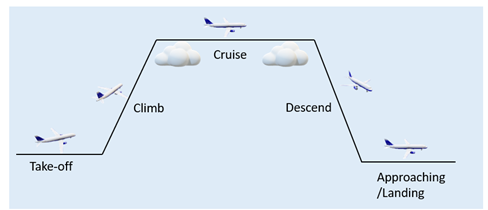
Fig. 8: Phases of a flight

Tab. 1: Comparison of flight time between two algorithms

Tab. 2: Comparison of fuel consumption between two algorithms
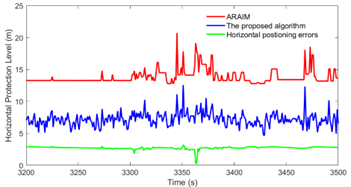
Fig. 9: Horizontal protection level of the proposed algorithm in the field test
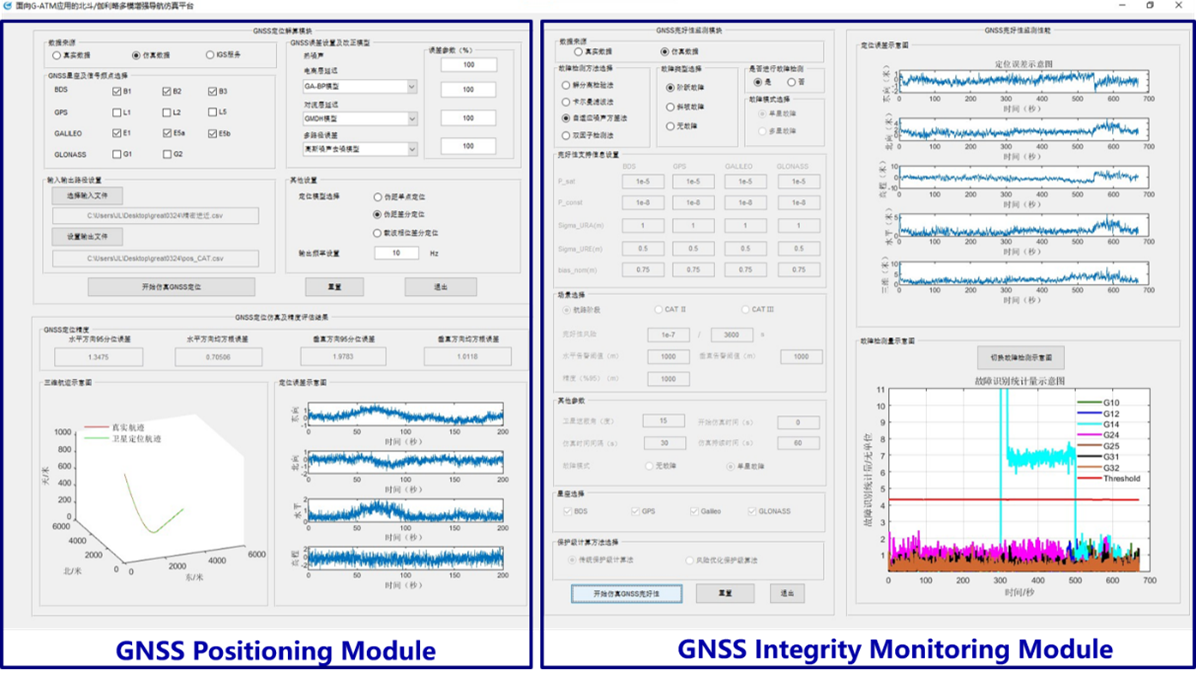
Fig. 10: Interface of the Beidou/Galileo multi-mode enhanced navigation simulation platform
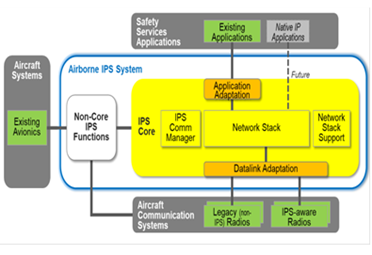
Fig. 11: Functional architecture of the ATN/IPS protocol stack
In the area of “Supporting Avionic System”, new technologies are being developed by the Chinese consortium for advanced airborne avionic systems that support greener long-haul and short-haul operations.
Research on airborne avionic system supporting TBO
Over the past six months, the focus has been on the trajectory planning problem with the goal of optimising the fuel consumption of an aircraft from one terminal to another. The existing typical algorithms were investigated: Artificial Potential Field (APF), Rapidly Random Tree (RRT), A*, Genetic Algorithm (GA), and Dijkstra. Then we analysed the performance, such as computational complexity and computation time of each algorithm.
Two superior algorithms (CL-RRT and Hybrid-A*) were selected for further investigation. Based on these algorithms, two sets of flight path optimisation index evaluation models were established, taking into account aircraft performance constraints, atmospheric environment, flight plan, control instructions and other constraints, as well as cost, flight time and fuel consumption.
Finally, the simulation verification of the flight trajectory planning algorithms was completed based on two idealized scenarios. Tab. 1 and 2 illustrate the comparison of flight time and fuel consumption between the optimisation algorithm and the baseline algorithm. In a next step we will further improve the algorithms by running more different scenarios.
Research on multi-constellation GNSS-based multi-mode augmentation technology for performance-based navigation
As an important criterion of navigation systems for safety-critical civil aviation applications, integrity is defined as a measure of trust in the navigation information. With the development of global navigation satellite systems (GNSS), Advanced Receiver Integrity monitoring (ARAIM) was proposed to monitor GNSS integrity in approach phases of airplanes. In ARAIM, however, the protection level that is supposed to envelop positional errors is very conservative.
Hence, to minimize the protection level, we proposed a multiple-variable and multiple-constraint gradient descent learning algorithm based on an integrity risk and continuity risk allocation strategy. In the field test as shown in Fig. 9, the protection level is reduced by over 30% on average and the positioning errors are enveloped simultaneously with the proposed algorithm.
The protection level calculation algorithm has been embedded into the Beidou/Galileo multi-mode enhanced navigation simulation platform, which is designed for not only validation, but also practical application of all the algorithms and models proposed within this activity. The interface of the software is shown in Fig. 10. The final version of the software has two modules, a GNSS positioning module and a GNSS integrity monitoring module. In the GNSS positioning module, real and simulated raw GNSS data can be processed with traditional and proposed error correction models to output positioning results. The integrity of the GNSS positioning results is evaluated by the proposed fault detection and exclusion methods and the optimized protection level calculation algorithm.
Research on L-band digital aeronautical communication system to support air ground data exchange
GreAT partner CARERI undertakes research on L-band broadband data communications for 4D trajectories. Up to now, the coding of applications such as FANS 3/C including CM, CPDLC and ADS, ATN protocol stack, etc. is completed and the system verification test report and patents are finalized as well. In short, the task required will be accomplished on time.
FANS 3/C, including CM, CPDLC and ADS, is a research hotspot. The ATN protocol and LDACS concerning FANS 3/C were successfully applied in this project. Meanwhile, system test report was prepared. In the future, CARERI will continue to improve the code and prepare the overall technical scheme of the system. The functional architecture of the ATN/IPS protocol stack is shown in Fig. 11.
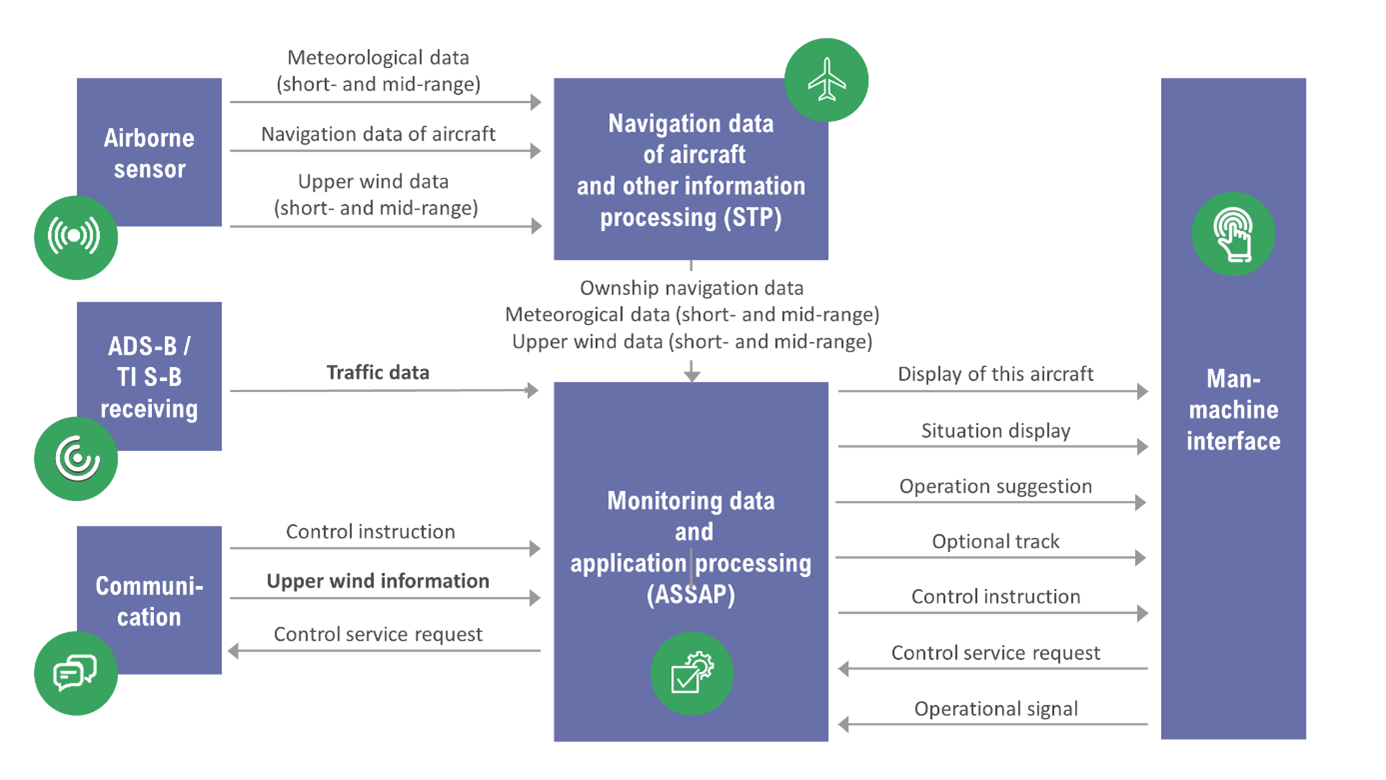
Functional architecture showing the interdependence of the different blocks / components of avionics systems
Which functions and performances of the airborne avionic systems are required to support greener air traffic operations? This is the core question in GreAT topic “Supporting Avionics Systems”. Since July 2020, research teams from CARERI, NUAA, CETCA and other supporting members have been working on the ATM avionics architecture design, GNSS (global navigation satellite systems) modelling, and LDACS (L-band digital aeronautical communication system) studies. Some initial results have been presented in technical reports and academic papers.
Function and performance requirements of the avionics systems for Greener ATM
To identify the requirements of the avionics systems, the Greener ATM operational and system architecture model delivered within the topic “Concept of Greener Air Traffic Operations“ was analyzed by the research team from CARERI. The roles and activities of the avionics systems were extracted and finely modelled. Subsequently, the researchers from NUAA built the error model of GNSS to evaluate the accuracy requirement of the airborne navigation system for Greener ATM. In the meantime, CETCA researchers analyzed the requirements of LDACS supporting 4D trajectory-based operations. In regular meetings all research parties involved shared ideas and results. The initial results have been concluded in reports and papers.
Outlook
The next steps will be the modelling the integrated avionics system based on the designed architecture, followed by simulation exercises verifying the function and performance requirements proposed in previous studies. Deeper results will be evaluated and summarized in the final reports.
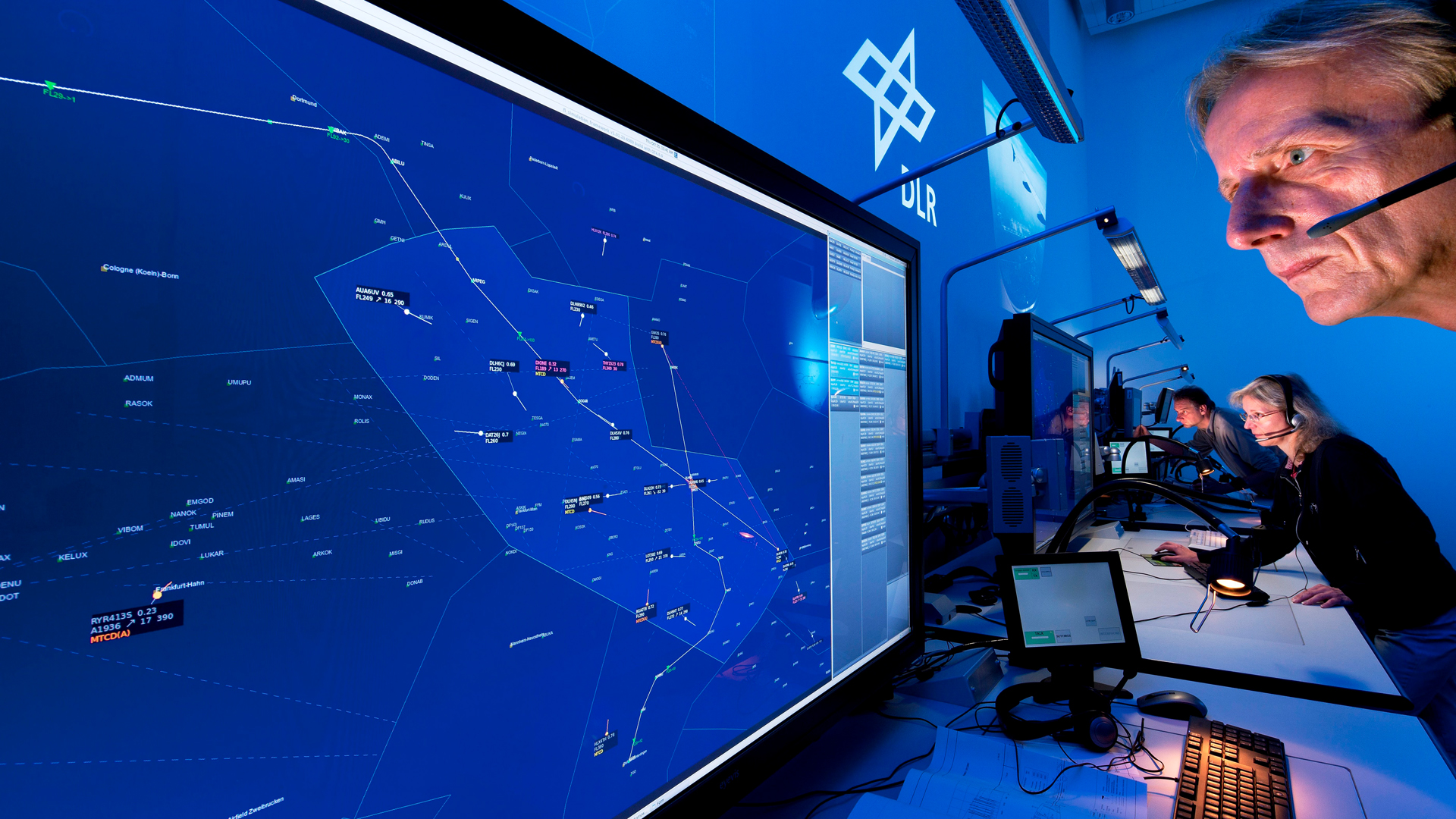
DLR’s TMA controller working position
This activity, solely carried out by the Chinese consortium, focuses on the development of ATM and avionics technologies, which support greener long-haul/short-haul operations, and covers three topics:
- 1. Research on airborne avionic systems supporting TBO aims to build a full ATM avionics architecture with the ability to organize resource, support service and for comprehensive utilization. The main challenge is to provide a top-level framework which defines the requirements and organizations of key subsystem of ATM avionics to form capabilities supporting greener operations. Some key technologies of supporting flight management system and human-machine interface will also be studied in this topic.
- 2. Research on airborne avionic systems supporting TBO aims to build a full ATM avionics architecture with the ability to organize resource, support service and for comprehensive utilization. The main challenge is to provide a top-level framework which defines the requirements and organizations of key subsystem of ATM avionics to form capabilities supporting greener operations. Some key technologies of supporting flight management system and human-machine interface will also be studied in this topic.
- 3. Research on airborne avionic systems supporting TBO aims to build a full ATM avionics architecture with the ability to organize resource, support service and for comprehensive utilization. The main challenge is to provide a top-level framework which defines the requirements and organizations of key subsystem of ATM avionics to form capabilities supporting greener operations. Some key technologies of supporting flight management system and human-machine interface will also be studied in this topic.
Although activities officially started in July 2020, some primary work has been done in advance, including performance requirement analysis of GNSS and LDACS.

Validation of Operational Benefits
Objectives
- To establish a comprehensive simulation environment;
- To validate the operational benefits;
- To assess feasibility (by system experts from relevant stakeholders, e.g., ATC, airlines, etc.)
Progress
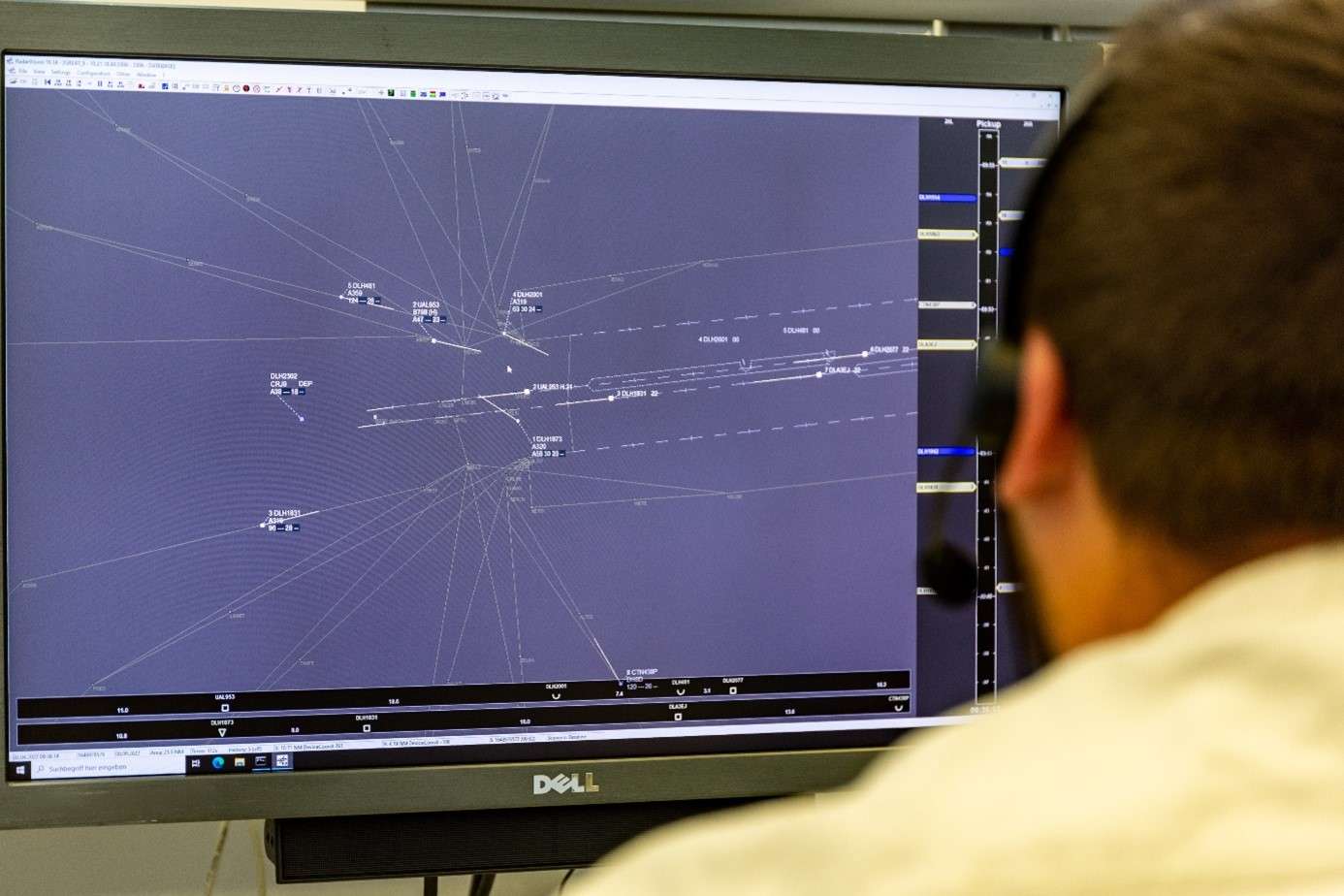
Fig. 12: Together with air traffic controllers from HungaroControl, some of the validation trials took place in Braunschweig
Several validation exercises were performed in 2022. The first exercise tested the MergeStrip tool which had to be installed on HC’s MATIAS-BEST simulator to be able to validate the What-if and the ML-based functionalities. As a second exercise performed at DLR’s Air Traffic Validation Center in Braunschweig, ten air traffic controllers from HungaroControl participated in the validation of the new planning and display functionalities Ghosting and TargetWindows as well as the GreAT airspace with Late Merging Point integration.
Setting up the validation environment
The simulation environment for the HungaroControl use case was set up in two clusters. First, to enable the validation of What-if functionality, MergeStrip had to be installed into the MATIAS-BEST (also known as miniMATIAS) simulator, as it was developed remotely from the validation environment. In this case, the system verification had to focus on the connection, i.e. whether the simulator can transmit and MergeStrip is capable of receiving CAT062 type of data converted into ADS-B format.
Second, for the validation of ML-based functionalities (Improved ETA and AI-based sequencing and speed control advisory”), as MergeStrip was already installed to a dedicated HungaroControl virtual server on the ATM-R platform, only a brief doublechecking against any changes on HungaroControl’s servers had to be carried out. Also, MergeStrip was tested on a client machine, and the tests proved that ADS-B connection was set up, MergeStrip could receive data from HungaroControl’s ADS-B antennas. This cluster consists of DailyFuel application as well, the very first application of DailyFuel in the HungaroControl environment, and as environmental KPIs have not yet been examined at HungaroControl in an APP environment, the results obtained in the framework of the GREAT project, DailyFuel can serve as a baseline for future validations.
On each of the ten validation days in May and September 2022 at DLR in Braunschweig, several traffic scenarios were run with a different proportion of 4D-FMS-equipped aircraft. The objective was to investigate whether controllers could integrate conventional traffic into the continuous descent approach (CDA) flow guided directly to the late merging points (LMP) using the visual and planning support functions of the AMAN and the prototype primary display RadarVision. ISA and F-ISA tests and interviews between and at the end of the validation runs were used to determine how the workload changes depending on the traffic mix. At the same time, approach routes and flight times were recorded to measure changes in route lengths.
Preliminary evaluations already show that the average approach distances of equipped aircraft can be reduced by several miles compared to standard approaches without simultaneously increasing controller workload. The reduced flight distances also reduce fuel consumption and, presumably, carbon dioxide emissions. We expect the complete evaluation and final results on this in early summer of this year.
Outlook
After the implementation of all developments on both sides and successful verification activities, the validation of the What-if functionality will be executed, followed by the validation of ML-based functionalities. With the detailed evaluation of approaches in terms of route lengths, fuel consumption, and carbon dioxide emissions, we will be able to make qualitative statements about the potential for reducing aviation emissions on approach by integrating LMPs while providing controller support systems.

A showcase flight from the trajectory file in „Franz Josef Strauß“ München International airport (EDDM) TMA
The validation activities of GreAT have moved to the next stage, and we are currently working on the verification plan. This particular phase aims to integrate data and ATC support tools developed in previous project activities into the simulator platforms, as specified in the Validation Plan. Both the European and Chinese partners will develop a Verification Plan with the same structure. The next steps will be the development of the validation environment and the platform integration.
Setting up the simulation environment – intensive preparatory work
The main purpose of this task is to design the functional composition and overall architecture of the simulation environment. The project partners involved will determine the existing simulation functions and means and simulation functions to be developed. On the European side, the verification and validation environment shall consist of two parts: fast-time ATC simulation and real-time human-in-the-loop simulations to support the evaluation of integrated support tools. The Chinese partners foresee real-time and automated simulations in ACC (Area Control Center) and APP (Approach) environments. Both consortia intend to conduct performance and environmental analyses and evaluations.
Two equally important tasks were identified within the environment development. The technical assembly will conduct design and development of missing simulation functions to complete the integration and docking of ATC simulation tools and perform simulation environment construction and debugging. In terms of environment configuration, all airspace related data will be implemented in the simulator environments for the respective hub and medium-size airports, e.g., airspace structure, SIDs (Standard Instrument Departure Routes), STARs (Standard Arrival Routes), sectorisation and constraints.
The selected traffic scenarios will also be implemented in the simulator environment and iteratively tested to ensure acceptance and suitability by the project team. Finally, data exchange formats, integration methods and data recording will be specified in preparation for result analysis.
The aim is to establish an effective link between the tools to be assessed and the developed simulation environments. Optionally, in addition to defined data recording procedures, the rapid generation and visualisation of key performance and environmental impact metrics can be included.
Outlook
The Verification Plans, which are currently being developed by the two consortia, are due by end of April 2022. Upcoming activities include the development of the validation environment development and platform integration.

Matias Best simulator at HungaroControl. Credit: HungaroControl
To validate the concepts developed within GreAT, the Chinese and European partners finally developed not only one, but two validation plans: one for Chinese and one for European ATM developments. Both plans follow the same structure and are based on common validation objectives. Reflecting GreAT's overall target, sustainability is the primary key performance area (KPA). Further KPAs to be explored are safety, capacity, efficiency, cost-efficiency as well as the human factor.
The validation plan, the first deliverable under work package 6, is a product of a smooth and outstanding collaboration of the project partners and takes the preceding work to the next level. Tutorial sessions on 24th and 25th February 2021 kicked off its development and laid down the ground for common work. They allowed deep insight into the respective ATM validation regulations, methodologies, practices, and facilities. The partners agreed to use common validation objectives, which were formally established during a workshop held on 19th March 2021 after six months of intensive preparatory work.
Sustainability at the Core
GreAT focuses on environmental sustainability. This, being the most important KPA, will be applied to all system developments, with one exception, where specific features of the development demand a different approach. Project members also acknowledged to explore all other KPAs (safety, capacity, efficiency and cost-efficiency) as mentioned in the grant agreement, and an additional one: Human factors. It must be noted that under the umbrella of GreAT, different ATM systems are intended to be developed. Therefore, the system-specific objectives were determined according to the characteristics of each system. Furthermore, use cases have been identified for both short-haul and long-haul operations. A separate workshop session devoted to exercise level development of the validation plan took place on 30th April 2021.
Two Harmonized Validation Plans
Finally, the project partners decided to develop two validation plans, one for Chinese and one for European ATM developments, each following the same structure, and ‒ as mentioned above ‒ based on common validation objectives. This decision creates a common understanding and framework on both continents, while respecting the differences in system characteristics and methodologies when carrying out their actual validation activities.
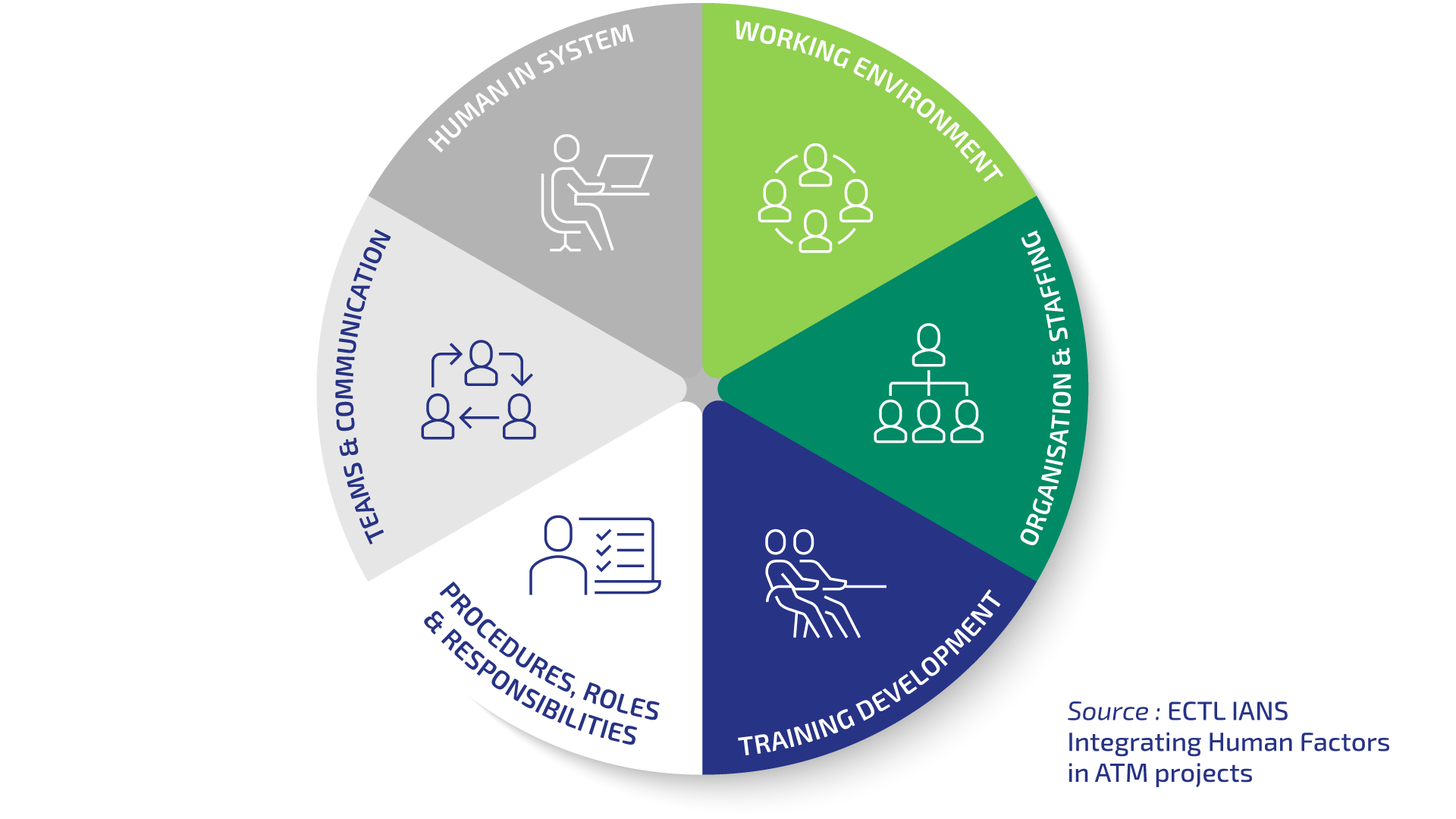
The purpose is to establish a comprehensive validation plan as well as a simulation and verification environment for the new greener trajectory concepts and technology of the previous research areas. The simulation environment should have two main parts: (1) Air Traffic Control (ATC) simulation and (2) aircraft simulation. The focus will be on fast-time simulations to assess the wide-area impact and, wherever suitable, real-time human in the loop simulations to validate most critical parts in a much more detailed way. It should be able to support the simulation verification and performance data analysis work of long or short haul green trajectory operation technology and airborne avionics function. The European consortium will focus on providing ATC-related operational simulations. The Chinese consortium will focus on providing simulation tools for airborne avionics functions. Both teams will jointly develop a verification environment. The overall objective is to demonstrate that the technical systems support greener flight trajectories through the reduction of CO2 emissions, NOx emissions and fuel consumption, whilst help to maintain airspace and airport capacity.
This building block will define the verification and validation methodology, establish the simulation environment and complete iterative evaluations. After every cycle the data will be analysed, which will also provide input for the next validation cycle. Each of them consists of preparing, re-adjusting the simulation environment, running the validation and data analysis and reporting.
These activities will ramp up from October 2020 on, and end with a validation results report, which will provide input for assessment of environmental benefits.

Assessment of Environmental Impact
Objectives
- To propose Key Performance Indicators to assess the positive environmental contribution of new concepts and operations in a comprehensive way;
- To define joint development measures for environmental and climate impact using new and more reliable physical and climate models;
- To perform a joint environmental impact assessment for the proposed technologies and procedures;
- To make operational refinements concerning the new approaches for short-haul and long-haul flights based on environmental impact assessment;
- To discuss the trade-offs between operational benefits and environmental impact;
Progress
Based on the scientific description of the impact of aviation emissions on climate, GreAT seeks to identify the key impact factors of aviation on climate change and use them as environmental impact assessment indicators, including fuel consumption, aviation emissions, air quality and greenhouse effect, etc., to establish a calculation model for the evaluation of the indicators.
The impact of aviation on the environment and climate change is still in the development phase and has varying levels of scientific certainty. It is generally accepted that CO2, NOx and contrails account for more than 95% of the total impact if cloud formation is disregarded due to the low level of scientific knowledge about its formation and effects.
Based on the scientific description of the impact of aviation emissions on climate, GreAT seeks to identify the key impact factors of aviation emissions on climate change characteristics. Two reports have already been produced, describing the impact of aviation emissions on the environment and the spatial and temporal distribution of aviation emissions.
Given the type of trajectories that are being investigated in the context of GreAT, the environmental assessments focus on CO2 and NOx emissions. The comparison parameter is the radiative forcing of each element. Since this is an instantaneous magnitude, the final impact indicator is the Global Warming Potential (GWP), which considers not only the instantaneous impact, but also the average lifetime of each emission. Different periods for the evaluation of the Global Warming Potential are being considered, given the different stability of each of the species in the atmosphere and therefore the presence in terms of time of the corresponding species.
An evaluation methodology has been developed and then implemented into a mathematical model and a software tool. This tool takes as inputs the trajectories being designed in other activities of the GreAT project and evaluates the environmental impact as an integrated index in order to perform the comparison of the greener trajectories with respect to the reference ones and thus facilitating the assessment of air traffic operations to determine how green air traffic performs.
The final step in the project will be the determination of potential trade-offs between the environmental impacts and the operational performance of the newly designed greener trajectories.
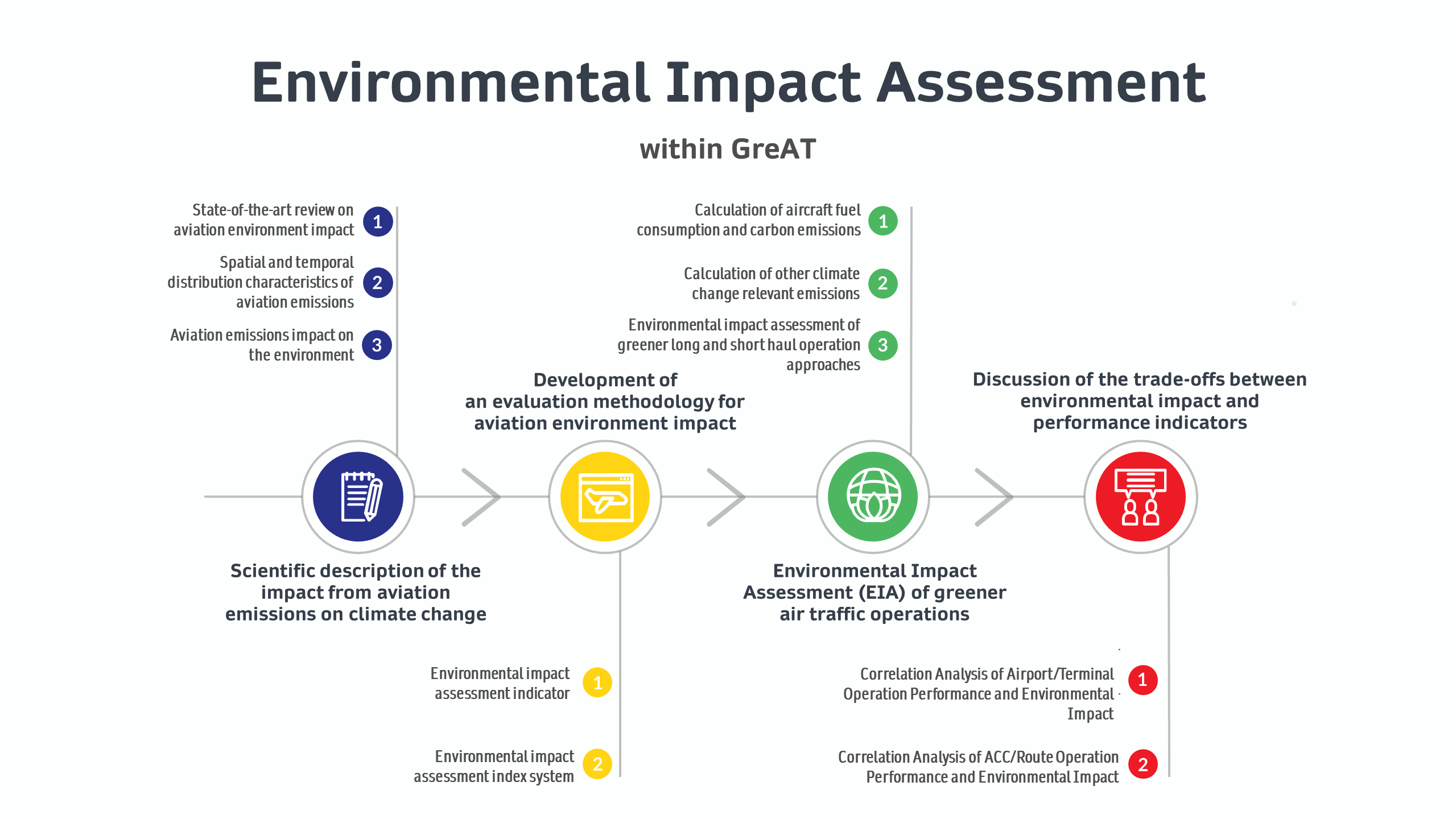
Activities to evaluate the environmental impact of the Greener Air Traffic concepts developed within GreAT
The objective of MWP7 is to evaluate assess the environmental impact from aviation pollutants, such as CO2 and NOx, on climate change. The preliminary steps include the establishment of common evaluation metrics, system and methodology. The fuel consumption and air pollutant emissions will be modelled and calculated scientifically. The improvements which 4DT-based green operational technology may bring in terms of climate change will be evaluated using an integrated validation method via multiple data sources. The tradeoffs between climate change impact and other environmental and performance indicators will also be studied.
The activities to evaluate the environmental impact of the concepts developed within GreAT were kicked off in July 2020 and started with a scientific description of the impact from aviation emissions on climate change. The results are described in the first deliverable, a report on the spatial and temporal distribution characteristics of aviation emissions. The next step will be to develop an evaluation methodology for the environmental impact. To prepare this, preliminary meetings have been held with the partners who are in charge of developing new operational concepts.
Impact of Aviation Emissions on Climate Change
The first step to accurately assess the impact from aviation emissions on climate change is necessarily a thorough state-of-the-art review of environmental impact assessment of aviation. While some effects are well characterized, such as CO2 emissions, there is a lack of scientific understanding of the effects of other substances, such as NOx and water vapor. Assessing aviation emissions close to the ground is relatively straightforward. However, it gets more complicated at altitude, as engine emissions - depending on the atmospheric layer - interact differently because of variable physical and chemical properties. The IPCC (Intergovernmental Panel on Climate Change) made a first attempt to gather the existing knowledge on this problem. This ambitious report was published in 1999. Since then, many more research studies have been performed. The main results are compiled in the first deliverable of this work package.
Assessment Methodology for Environmental Impact
Currently, the project partners are cooperating closely to develop a methodology to evaluate the environmental impact of the new operational concepts developed within GreAT. This methodology will enable the project team to quantify the improvement potential of the greener air traffic operations and will enable to discuss the trade-offs between environmental impact and performance indicators.

The objective is here to evaluate the environmental impact of aviation pollutants such as CO2 and NOx, on climate change. The main approaches include the establishment of common evaluation metrics, system and methodology. The fuel consumption and air pollutant emissions will be modelled and calculated scientifically. By integrated validation via multiple data sources, the improvement of 4DT-based green operational technology on climate change will be evaluated. The trade-offs between climate change impact and other environmental and performance indicators will also be studied.
These activities started in July 2020, and only preliminary preparatory tasks have been performed, to coordinate the actions of the different participants.